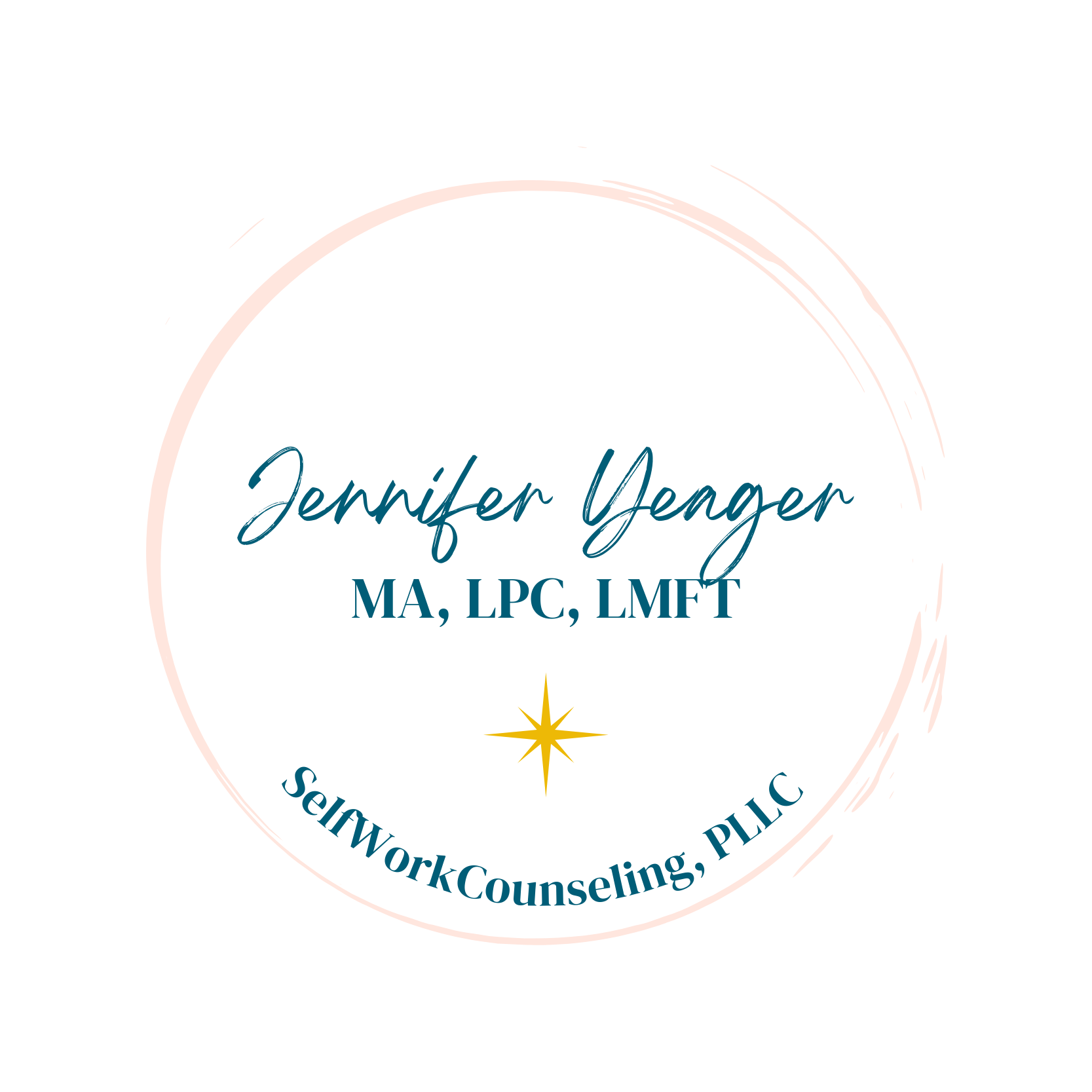Starting the New Year: Reflect, Release, Renew
Jennifer Yeager • January 3, 2025

Starting the New Year: Reflect, Release, Renew
As the new year begins, we often focus on resolutions tied to external achievements—losing weight, earning more, or learning new skills. While these goals can be meaningful, the start of a new year is also an invitation to nurture what truly sustains us: our mental health and the quality of our relationships.
This year, consider approaching your goals with the theme: Reflect, Release, Renew.
Reflect: Learning from the Past
Take time to pause and look back on the past year with curiosity and compassion.
- What went well?** Celebrate your wins—big and small.
- What challenged you?** Acknowledge the difficulties without judgment.
- What did you learn?** Reflect on how those experiences have shaped you.
Reflection is not about getting stuck in the past but understanding it so you can move forward with greater clarity and intention.
Release: Letting Go of What No Longer Serves You
The new year is a perfect time to release old habits, thoughts, or relationships that weigh you down.
- Release Self-Criticism**: Embrace self-compassion and let go of the pressure to be perfect.
- Release Resentments**: Consider forgiveness—not for others, but to free yourself from the burden of anger or hurt.
- Release Unrealistic Expectations**: Allow yourself to redefine success in a way that aligns with your values.
Letting go creates space for what truly matters.
Renew: Embracing Growth and Possibility
Renewal is about stepping into the new year with a sense of purpose and hope.
- Set Intentions**: Focus on how you want to feel or who you want to become, rather than rigid goals.
- Prioritize Connection**: Strengthen your relationships with consistent acts of care and vulnerability.
- Invest in Yourself**: Commit to practices that nourish your well-being, whether it’s therapy, mindfulness, or rest.
Renewal is not about changing everything overnight but taking small, meaningful steps toward the life you want to create.
Looking Forward:
This year, embrace the power of reflection, the freedom of release, and the excitement of renewal. By prioritizing your mental health and relationships, you can create a foundation for meaningful and sustainable change.
Wishing you a year of growth, love, and fulfillment.

With Fall comes the gentle reminder that in order to make room for the new, we must let go of what no longer serves us. Just as the trees release their leaves, we too are invited to release. While letting go may feel uncomfortable—sometimes even scary—the falling leaves remind us that in every ending, space is created for a new beginning. Autumn whispers to us: you don’t have to hold on so tightly. Nature shows us that letting go is not about loss, but about creating space for renewal, growth, and possibility. What Might You Let Go Of? Letting go can take many forms. It might be: Old resentments that weigh on your heart. Material items that clutter your space and energy. Behaviors or patterns that no longer align with who you are becoming. Unhealthy beliefs that keep you from stepping into your full self. You don’t have to release it all at once. Simply softening to the idea of letting go can be the first gentle step. Create a Soft Space for Yourself As you lean into this season of release, remember that gentleness is key. You might: Wrap yourself in a cozy blanket. Sip a warm cup of tea. Sit quietly with your fur-baby. These simple acts of self-soothing create a safe space for you to explore what’s ready to be released. Journal Prompts for Reflection Take some time with your journal and explore: What am I holding onto that feels heavy or draining? What beliefs, habits, or patterns no longer support my growth? If I were to let go of one thing today, how might it create space for something new? What does the image of a tree releasing its leaves teach me about my own process of release? How can I support myself with compassion as I practice letting go? Closing Reflection Letting go is not about rushing or forcing. It’s about softening. When the time feels right, allow yourself to release—just as a tree effortlessly lets go of its leaves. In that surrender, you create space for renewal, healing, and the blossoming of something new. This Fall, may you find the courage to release and the gentleness to nurture yourself in the process.

Like many of you, I’ve found myself thinking about the families who sent their children off to summer camp—full of love, care, and hope—only to be met with the unimaginable. As a mom, this one hits especially close. I can vividly remember the swirl of emotions that come with sending my child off to camp. The careful packing. The little pep talks about trying new things. The hugs goodbye. The silent prayers whispered as you drive away: Please let this be a week of laughter, of friendship, of fun and growth. We trust others to care for our children. We hold space for both their independence and our fears. We look forward to the stories shared on the ride home and maybe a bag full of dirty laundry and happy memories. Nothing can prepare you for the phone call or news alert that shatters all of that in an instant. I cannot comprehend the horror of receiving that news and not knowing if your child is safe. The powerlessness. The not knowing. The desperate need for information. The agony of waiting, of imagining, of trying to hold on to hope while fearing the worst. To the families who lost their daughters: I am so, so sorry. There are no words that will ever be enough. As a mother, my heart breaks for you. I see you. I’m holding you in my heart. To the campers, counselors, and staff who lived through the flood firsthand—please know that your fear, your grief, your trauma are all real and valid. These experiences don’t just go away. They live in the body, in memory, in the quiet moments when everything catches up to you. You don’t have to carry that alone. To those who were there—who tried to help, who were caught in the chaos, who watched in helplessness and horror—please know: what you went through matters. You may be left with haunting images, recurring sounds, or painful flashbacks. You might find yourself swinging between numbness and overwhelm. All of that is part of the mind and body trying to make sense of something that simply doesn’t make sense. You are not alone. To the first responders—thank you. Truly. You stepped into unimaginable circumstances with bravery and compassion. You carried other people’s fear while managing your own. You brought people home. You hold stories that most of us will never know, and you carry a weight few can understand. Thank you for showing up with such fierce humanity. And to the wider community—those of us watching from afar, feeling helpless or heartbroken or unsure of what to do—please know this: there’s no “right” way to grieve or respond to something like this. Whether you’re feeling numb, angry, terrified, or deeply sad—your feelings are valid. They deserve care, too. As a therapist—and more importantly, as a fellow human and a mom—I want to say this clearly: if you are one of the families impacted, if you’re a parent, a sibling, a grandparent, a friend—my heart is with you. Nothing anyone says can undo what happened. But I want you to feel seen in your grief, your rage, your confusion, and your deep, deep sorrow. Trauma doesn’t disappear just because the headlines fade. Tragedy leaves a mark. And healing doesn’t happen in isolation—it happens in connection, in community, and over time. So please: take gentle care of yourself and the people around you. Reach out if you need support. Let yourself cry. Let yourself rest. Hug your people. Be a little softer with strangers. If you’re someone holding space for others—keep showing up, even when the world gets quiet again. In moments like this, we are reminded of the fragility of life—and also of the strength we carry together. May we hold each other close. May we extend grace freely. And may we make room for every feeling that comes with heartbreak. My heart is with every person affected by this tragedy. With care, Jennifer

Infidelity is one of the most deeply painful experiences that can happen in a marriage. Whether it’s a physical affair, an emotional connection outside the relationship, or even digital betrayal, the discovery often sends shockwaves through every part of a couple’s life. If you're reading this, there's a good chance you're trying to make sense of something that has turned your world upside down. You may be feeling broken, disoriented, or unsure if your relationship—or your heart—can ever recover. You're not alone. And while there’s no one-size-fits-all roadmap, healing is possible. The Earthquake of Betrayal When infidelity enters a marriage, it's rarely just about the behavior—it’s about what it represents. For the betrayed partner, it often feels like the foundation of safety, loyalty, and shared reality has been pulled away. What was once assumed—“I can count on you,” “We’re on the same team”—is suddenly up for question. Many describe it as a kind of relational trauma. That’s because betrayal doesn’t just hurt—it can dysregulate your nervous system. You may feel on high alert, unable to sleep, obsessing over details, or even questioning your own memory and worth. The emotional pain can feel physical. The anxiety and panic may come in waves. This is not weakness. This is your body trying to make sense of a deep rupture in trust. For the Partner Who Had the Affair If you’re the one who was unfaithful, you might be carrying your own form of pain—shame, guilt, regret, confusion. You may be facing the reality of how your actions have impacted someone you care about, and you might also be reckoning with your own unmet needs, patterns, or blind spots. It’s possible to hold both accountability and compassion—for yourself and for your partner. But it starts with honesty: not just about what happened, but about what it meant. Infidelity often points to disconnection, avoidance, or unresolved pain that wasn’t being named or tended to in the relationship—or within the self. What Infidelity Can Reveal About a Relationship Contrary to popular belief, affairs don’t always happen in “bad” marriages. Sometimes the relationship looks functional on the surface. But underneath, there may be emotional distance, avoidance of conflict, resentment, loneliness, or a loss of intimacy. Infidelity can expose these buried dynamics. While that doesn’t justify betrayal, it helps us understand it. And when both partners are willing to look beneath the surface, there’s potential for real growth. That said, the betrayal must be addressed first—before the relationship can be rebuilt. The betrayed partner must feel emotionally safe enough to share their pain without being minimized, blamed, or rushed to forgive. Rebuilding After Infidelity: What Does Healing Actually Look Like? Healing after infidelity isn’t about “getting over it.” It’s about moving through it with intention, truth, and care. Here’s what that often involves: 1. Emotional Safety and Stabilization Before repair is possible, the betrayed partner must feel emotionally safe. This means the affair is over, communication is honest, and emotional reactions—however intense—are met with empathy, not defensiveness. 2. Truth-Telling and Transparency The truth is painful, but secrets and lies prolong the suffering. Couples often need a structured space (like therapy) to talk about what happened, why it happened, and what it means moving forward. 3. Grieving the Loss Even if the couple stays together, something has been lost—the “us” that once was. Both partners may need to grieve not just the affair, but what the relationship used to represent. 4. Exploring the Deeper Roots Why did this happen? What was going on internally, relationally, or historically that made space for betrayal? This isn’t about blame—it’s about insight, pattern awareness, and growth. 5. Rebuilding Trust (Slowly) Trust doesn’t come back all at once. It’s rebuilt in hundreds of small moments: showing up consistently, being emotionally present, telling the truth, and staying steady when emotions are high. 6. Reconnecting with Intimacy True intimacy—emotional, physical, spiritual—can be rebuilt over time. But it must be mutual, chosen, and safe. Some couples discover deeper layers of connection than they ever knew possible. Should We Stay Together? Not every couple chooses to stay together after an affair. Some relationships end, and that can be a path to healing too. What matters most is making that decision with clarity—not from a place of fear, reactivity, or unresolved trauma. Therapy can help couples slow down, explore all sides of the situation, and make decisions with dignity and self-awareness. A Gentle Invitation If you’re hurting right now—if you feel lost, angry, numb, or unsure of what to do next—I want you to know this: Your pain is real. Your story matters. You deserve support that honors the complexity of what you're going through. Whether you want to repair your marriage, understand what happened, or simply find your footing again, you don't have to walk this path alone. Therapy offers a place to be heard without judgment—and to discover what healing can look like for you.



